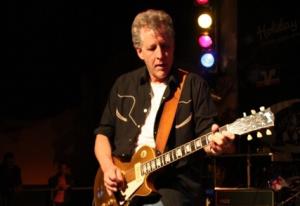Talkin' Blues: New Orleans, Part 1

American music—blues, jazz, R&B, country and all the rest—were formed from the blending and reblending of African, Caribbean and European musical elements in the social cauldron of these United States. New Orleans, Louisiana—a.k.a. NOLA—was a crucial first point of cultural contact and cited mainly as the birthplace of jazz, but by the early Fifties, New Orleans was also home to a distinctive style of rhythm and blues. The difference was in the rhythm itself. Records coming out of the city began featuring an unusual blend of ingredients like tresillo, triplets, backbeat, two-beat and second line (or parade beat).
Tresillo describes the first, syncopated half of the son clave rhythm underlying Afro-Cuban music, better known in America as “Bo Diddley” or “shave and a haircut, two bits” (FIGURE 1; notated for ease of comparison in 4/4 rather than standard 2/4 meter). Early New Orleans pianist Jelly Roll Morton described the tresillo and related habanera rhythm as the essential “Spanish tinge” of jazz, a thread that also ran through ragtime, Charleston and southern gospel ring shouts.

After influential New Orleans bandleader Dave Bartholomew made it the central theme of his 1949 hit “Country Boy” (similar to FIGURE 2), variations on the tresillo pattern became a standard feature of NOLA rhythm and blues. With acoustic bass and electric guitar doubling the figure beneath steady piano triplets (a style that became a trademark of Fats Domino) and augmented by a backbeat—a hard snare-drum accent on beats two and four of each bar, identified with NOLA drum kingpin Earl Palmer—the result was a powerful, strolling groove that drove New Orleans–recorded hits by Domino (“Ain’t It a Shame,” “Blueberry Hill”), Guitar Slim (“The Things That I Used to Do”), Smiley Lewis (“I Hear You Knocking”) and countless others.


Aside from doubling the bass pattern, this groove offers several options for rhythm guitar. Start by harmonizing the backbeat with chicks, or sharp chord accents, on the high strings (FIGURE 3; the examples show patterns for I, IV, and V chords that can be assembled into various progressions). In a piano-less lineup, the guitar can play triplets using major triads or dominant seventh chords (FIGURE 4; continuous triplets in 4/4 are typically notated in equivalent 12/8 meter).


In a small band, combine parts to fill out the sound: for example, use bass plus chicks (FIGURE 5) or bass plus triplets (FIGURE 6; pick with downstrokes, or if the tempo isn’t too fast, use hybrid picking. A capo is recommended for keys other than A).

FIGURE 7 shows an adaption of a classic NOLA piano intro that can be plugged in front of almost any tune with this sort of groove (note the recommended picking pattern). For solos, just climb atop that mountain of rhythm and play the blues.
Next time: Walking to New Orleans.
Part 1
Part 2
Part 3
Part 4
Get The Pick Newsletter
All the latest guitar news, interviews, lessons, reviews, deals and more, direct to your inbox!
“There are so many sounds to be discovered when you get away from using a pick”: Jared James Nichols shows you how to add “snap, crackle and pop” to your playing with banjo rolls and string snaps
Don't let chord inversions bamboozle you. It's simply the case of shuffling the notes around







![Joe Bonamassa [left] wears a deep blue suit and polka-dotted shirt and plays his green refin Strat; the late Irish blues legend Rory Gallagher [right] screams and inflicts some punishment on his heavily worn number one Stratocaster.](https://cdn.mos.cms.futurecdn.net/cw28h7UBcTVfTLs7p7eiLe.jpg)


